As the winter garden outside slumbers my high impact houseplants give the chilly gardener an indoor gardening fix. Here are a few of my favourites – those that dangle from cupboards and shelves, those that simply grow huge and some smaller ones that add colour and variety…
Tradescantia zebrina – spiderwort
When it comes to houseplants, having a range of colours and textures is important if you want to create impact in the home. All green can be dull but throw in some colour and variegation and a houseplant collection will have some zing. Tradescantia zebrina brings burgundy tones and silvery shine. In certain lights the silver stripes look like they’ve been brushed on with metallic paint.
It’s a great one for dangling from a shelf, where it can break up a display of books or ornaments. Be warned, it will soon outgrow a table so if you do get one, think ahead, as within a year or two each strand will be 2-3 feet long (see photo below), at which point it can look a bit unruly. It does root easily from cuttings though so when each strand gets too long, I’ll cut it in half and poke the cut strand back into the pot to root higher up for a bushier overall effect. The cuttings also root very easily in water so you can create more plants to give away to friends.
Lepismium bolivianum

Tradescantia zebrina (left) with Lepismium bolivianum (right)
This plant is fantastic for impact as it has such an unusual habit and a very striking fresh green colour. It is made up of long, flat fleshy tubes that grow downwards and branch appealingly. Again, this is a plant that needs a high home as they can grow to several feet it length. Sometimes it gets confused for a plant called Rhipsalis paradoxa, which has similarly long, fleshy, trailing branches. I thought mine was a Rhipsalis until just recently when someone on Twitter set me right. It just goes to show how sometimes things can be mislabelled in shops and garden centres.
As with the trandescantia, the strands are fairly easy to root so, again, I sometimes cut the strands and poke them into the pot. Once rooted, the cuttings will also branch downwards to create a shimmering green waterfall. The plant above is two years old and is 4 times the size of when I first bought it.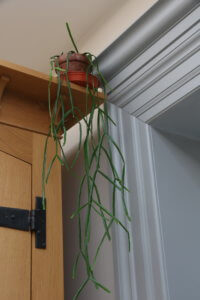
Here’s a picture of a baby one, from the mother plant above. It’s more of a trickle than a cascade so every now and again I add a cutting in the pot at the top.
Alternatives to these two trailing plants are scindapsus pictus (Satin Pothos plant) and philodendron scandens (Prayer plant). I grow these tumbling from pots and hanging baskets and just as with the tradescantia and rhipsalis, have rooted cuttings from unruly strands back into the pot above, for bushier effect.

Philodendron scandens

Scindapsus pictus
Philodendron
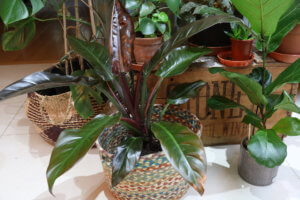
Philodendron ‘Red Imperial’
Attractive colour and leaf shape are what makes a great plant but add in shine and you have the holy trinity of houseplant heaven. You cannot beat a Philodendron for sparkle and shine. The newest to my collection is Philodendron ‘Red Imperial’ with leaves so mirrored you can almost see you face in them.
When I bought this plant, the leaves were dull and dotted with chalky marks from where it had been watered overhead with hard water in the garden centre. The sparkle was restored with a wash of neem oil diluted with water. My philodendron ‘Xanadu’, got the same treatment last week.

Philodendron ‘Xanadu’
Swiss Cheese Plant – Monstera deliciosa
These favourites from the 70s were out, then in, and now I hear they’re out again. Unless I accidentally kill something, I believe a houseplant is for life. The very idea of junking a plant because it is no longer “in” doesn’t make sense, especially when the leaves are as big and beautiful as my monsteras.
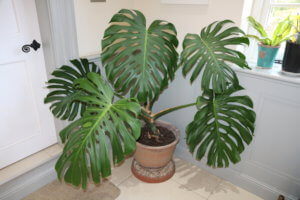
I have 7 monsteras in my home, ranging from the gigantic to the merely wannabee enormous. All but one are cuttings from a mother plant which is at least 55 years old. If you want to know more about the story behind this ancient plant you can read another article where I describe its history whilst also talking about how to set about taking cuttings from monstera deliciosa. These are my number one plants for impact, not just because they can grow to have spectacular, gigantic notched leaves but because they are so easy to grow. They’ll take dry homes, low light and a fair amount of neglect. 
Monsteras are essentially climbers but need the support of a host plant in the wild and usually therefore need some support in teh home. Some I grow wound round canes or poles. The older ones, taken from cuttings of a large old plant, have hefty woody stems that, for now, they can support themselves. A final one is growing up a string nailed into an overhead beam – so they’re versatile too and you can create different effects depending on how you train them.
High impact plant for free – Avocado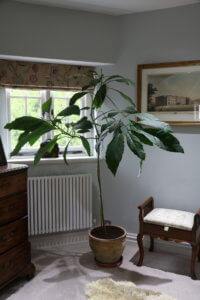
I’ve included this one as many impactful houseplants are expensive and yet this one is free. I have four avocado plants growing in my home and each one came from the stone of an avocado pear that we’d had for lunch. All you have to do is dangle the stone over water (I use cocktail sticks to support them over a jam jar). The roots come first, then the shoot and I then pot them into compost.

The largest avocado is now a branching tree which has outgrown the kitchen and has had to move onto the landing. I achieved the branching effect by bravely chopping off the stem and allowing it to shoot from where I’d chopped it. Sometimes it just sends the new shoots straight up but if you wait until its 3 or so feet tall, i’ve found it’ll be more likely to branch well. This one has three main branches and has just sent a fourth one out towards the window.
Houseplants for colour – Saintpaulia and Fitonnia

Fittonia albivenis ‘Skeleton’

Fittonia albivenis ‘Skeleton’

Saintpaulia – African Violet
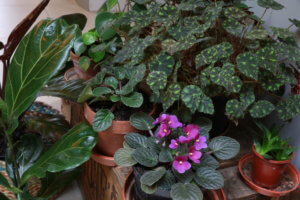
African Violet in a mixed group of houseplants – from left to right – Fiddle Leaf Fig, Pilea peperomides, two african violets and Begonia Rex.
Neither of these plants is large enough to add much impact in the home on their own but add them to a grouped houseplant collection and they’re transformational.
I don’t understand why African Violets aren’t more celebrated? I really like them though and once I learned to water them from the saucer to prevent marking the leaves, I have found them easy to grow. I also like the fact that they tend to flower in the UK autumn and winter when we relish their colourful blooms. The leaves can be green or burgundy and the flowers range from plum, to violet to deep purple and can even be stripey.
Meanwhile, the Fittonia albivenis ‘Skeleton’ provides its punch in the crazy pink veined leaves. I bought this and was scared stiff by reports of it needing very specific growing conditions – low to medium light, high humidity and free draining but moist soil. Certainly it scorched in my very bright greenhouse but it has been fine under a skylight in the kitchen in fairly dry air. I have found it easier to care for in a clay pot as I think a plastic pot can suffocate it a bit. This plant is a year and a half old and has expanded slowly outwards and may soon need a repot.
This seasonal diary is part of a weekly link-up of garden bloggers from around the world, called Six on Saturday. For more information and links to other blogs crammed with gardening activity, check the blog of host The Propagator.





The houseplant topic is one that I tend to avoid as it fills me with guilt. I’ve had many houseplants over the years, but the all, without exception, die, and usually of neglect. Many years ago I stopped buying them for that reason, but I do have this feeling (and especially after reading your post) that I should bring some into the house and love them and care for them as much as I love & care for their outdoor cousins.
Maybe you’ve made a convert. I’m not sure that was a good idea though, but I’m drawn to the glossy Philodendrons and the gorgeous Fittonia albivenis ‘Skeleton’. A few African violets would certainly cheer me up on a dismal day. I really, really need one of those on my desk.
Lovely post, Katharine.
Hi Catherine – I do hope you give it another go. I have had my fair share of failures but all of these ones seem to take a bit of neglect, part from maybe the fittonia which flags when it dries out. I find the worst thing you can do to most houseplants is to overwater, so I tend to do this just once a week. I remember now that my late mother would do this every saturday. She wasn’t really one for routine but this was one that clearly worked for her. Good luck.
My nan always used to grown African Violets. I’d forgotten until I read this. Wow to the avocado plants!
Hi Graeme, I almost wrote something about great aunts and nans growing African Violets. It did used to be a thing didn’t it? I think they’re due a resurgence!
What gorgeous indoor plants! You have good taste and a large choice.
This big avocado gives a very nice effect. I had already tried growing them, but unfortunately most of them failed ( at the second or third stage of your second photo).
With the low light in winter and the radiator next to it, it seems healthy! I’m impressed
The big avo has only been on the landing for a week so I’m keeping an eye on it. It does receive good light from two directions but I’ll have to move it if it begins to struggle. I have another next to a radiator already and it really doesn’t seem to mind. It’s all trial and error.
What amazing house plants! So healthy but you do obviously look after them. I’m afraid I couldn’t grow an avocado plant because I would have to eat the avocado first. 🤢😱 Not my favourite. Lovely “Six”?-on-Saturday . 😉
Thanks Granny – yes you’d need to get over your avocado aversion first! I quite like them and my daughter loves them. I don’t spend too much time with my houseplants but most are in the kitchen which means they’re in view all the time and I notice when they’re flagging or if a pest moves in. It’s also a good place for houseplant – a good north-facing windowsill which is bright enough but not baking with direct sun – and a bright skylight with lovely overhead light. Having good growing conditions definitely helps.
I think African violets are underrated too. For some reason the flowering plants don’t seem as popular as ones with striking foliage. The colour of the Fittonia leaves seems quite unreal. Well done for keeping it going, when it is so particular about its growing requirements.
I’m not sure the Fittonia is as particular as some of the websites I’ve read have made out. It’s still alive for me anyway! Maybe african violets will stage a comeback. I guess they’re a bit boring when not flowering but boy when they flower it’s worth it.
Fabulous plants. So shiny and clean! I have Tradescantia Zebrina too and use it to screen my water butt in the summer. It comes in for winter but I struggle to find a good place for it. The problem I find with cascading plants is watering them if they are on top of a cupboard – how do you do it? I tend to neglect them as am too lazy to get a chair to stand on 😂
Yes, you’ve hit the nail on the head – I have to stand on the kitchen chair. I don’t mind that so much but they’re so high up it’s hard to see the saucer to gauge when to stop. Occasionally I get a bit damp!
A wonderful selection
Thanks Paddy.
My mother always had a collection of African violets. I haven’t seen any for sale here – maybe I should investigate further.
Hi Barbara – I do hope you find some! They’re really growing on me.
I’m delighted by the Lepismium. Will have to look into acquiring one for my collection. The silvery color and markings on the Satin Pothos are lovely. I like the idea of growing avocados from pit as houseplants. How did you get your Philodendron Xanadu looking so healthy? I have had one for several years whose leaves remain sparse and diminutive. Have you tried any Rhipsalis?
I thought my Lepismium was a rhipsalis until someone told me it wasn’t. I would like to get one though. It’s been trial and error with the Philodendron. I make sure the compost doesn’t dry out as it doesn’t seem to like that. I also give it liquid feed (usually Baby bio) during the summer. The biggest problem with it has been scale insects – which I’m still battling. The shine came from a neem oil wash that I brushed every single leaf with, underside as well as top. This helps to control the scale insect and the shine is a good side effect!